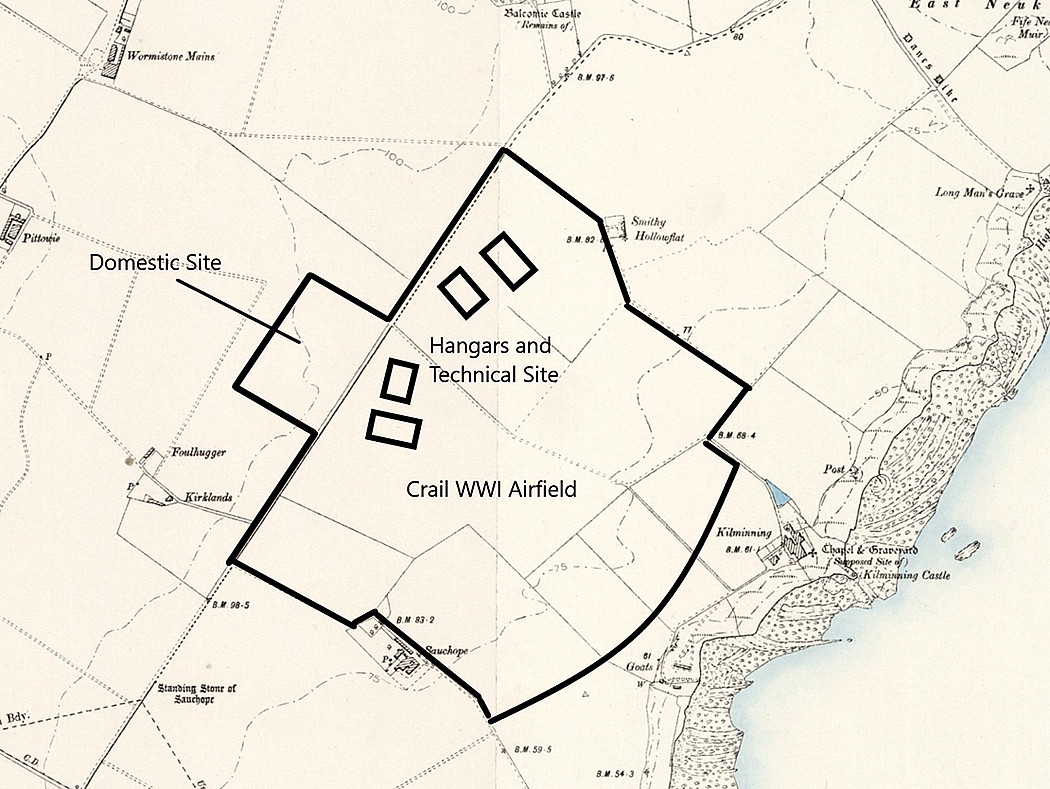Crail
CRAIL: Military aerodrome Royal Naval Air Station
(HMS JACKDAW 1948 HMS BRUCE) Later private airfield
Note: All four of these pictures were obtained from Google Earth ©
Military users: WW1: RAF Training Depot Station
104 Sqdn (Airco DH9, Airco DH10 Amiens)
WW2: RNAS, Fleet Air Arm. Torpedo Training School and Aircraft Torpedo Development Unit
It has been recorded that during WW2 the following Fleet Air Arm Squadrons had a presence here, no doubt mostly short-lived and for training purposes:
711 Sqdn, 747 Sqdn, 758 Sqdn, 770 Sqdn, 778 Sqdn, 780 Sqdn, 785 Sqdn and 786 Sqdn
CRAIL was clearly a very busy Station during WW2.
800 Sqdn, 810 Sqdn, 811 Sqdn, 812 Sqdn, 816 Sqdn, 817 Sqdn, 819 Sqdn, 820 Sqdn, 822 Sqdn, 823 Sqdn, 826 Sqdn, 827 Sqdn, 828 Sqdn, 829 Sqdn, 831 Sqdn, 832 Sqdn, 833 Sqdn, 834 Sqdn, 836 Sqdn, 837 Sqdn and last but not least 846 Sqdn. Have I missed any?
Also, No.4 Ferry Flight, plus it appears No.50 Training Squadron of the RAF.
Looking up the history of the Fleet Air Arm squadrons in WW2, (and yes it does take a while), it would appear that the following types of aircraft were probably to have been seen here. In alphabetical order:
From the UK: Blackburn Roc and Blackburn Skua. Fairey Albacore, Fairey Barracuda, Fairey Firefly, Fairey Fulmar and of course the redoubtable Fairey Swordfish. Plus, the Supermarine Walrus and Vickers Supermarine Seafire
Supplied from the USA: Grumman TBF/TBM Avenger, Grumman F6F Hellcat and Grumman F4F Wildcat. Vought SB2U Vindicator and Vought F4U Corsair
Note: The Grumman Wildcat was known in FAA service as the Martlet. The Vought Vindicator as the Chesapeake. Initially the Grumman Avenger was called the Tarpon and the Grumman Hellcat the Gannet. It appears that in 1943, to aid simplicity, the practise of adopting British names was stopped, the types reverting to their American names.
Operated by: 2000: Mr William J Robertson (CRAIL Airfield Promotions)
Location: 1nm E of Crail, 8.5nm SE of St Andrews town centre
(In 2001 one flight guide says it is 10nm S of St Andrews)
Period of operation: Military: 1918 to 1958 (Continuous operation?)
Civil: ? to 2000 certainly
Site area: WW1: 172 acres 960 x 777
Note: These three maps were kindly provided by Mr Michael T Holder
Runways: WW2: 02/20 914x30 hard 06/24 1097x30 hard
11/29 914x30 hard 15/33 914x30 hard
2000: All listed as being 1000x10 hard but this is of course a generalisation
2001: Only runway 08/26 was available for use (Presumably 06/24 from WW2)
NOTES: It was Mr Robertsons opinion that this was, (in 2000 at least), one of the best preserved and abandoned WW2 aerodromes in Scotland.
In 2020 I was told that it is said that runways 08/26 and 17/35 were still usuable. Maybe short sections were but they do not appear marked, and appear to have a fairly rough surface? Any advice will be much appreciated.
We'd love to hear from you, so please scroll down to leave a comment!
Leave a comment ...
Copyright (c) UK Airfield Guide






















